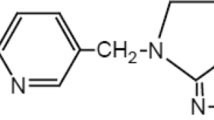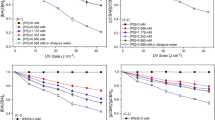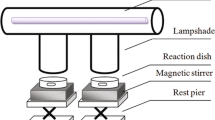Abstract
The mechanisms and reaction pathway of UV photo-assisted Fenton-like degradation of progesterone in water and wastewater were investigated. The reaction followed the pseudo-first-order kinetics for both the dark Fenton-like and UV photo-Fenton-like processes. The reaction kinetics of the UV photo-assisted process improved with the presence of humic acid (HA) in wastewater, due to the formation of Fe(III)-HA complexes which enhanced Fe(II) production by a ligand-to-metal charge transfer. The UV photo-assisted process reduced the amount of ferric required to completely degrade progesterone by 60 % and lowered the activation energy to 42 kJ/mol compared to 104 kJ/mol for the dark Fenton-like process. Complete degradation of progesterone was achieved through a multi-step process involving several intermediate compounds.







Similar content being viewed by others
References
Alalm MG, Tawfik A, Ookawara S (2015) Degradation of four pharmaceuticals by solar photo-Fenton process: kinetics and costs estimation. J Environ Chem Eng 3:46–51
APHA (2012) Standard methods for the examination of water and wastewater, 22nd edn. APHA, Washington, DC
Aygun A, Yilmaz T, Nas B, Berktay A (2012) Effect of temperature on Fenton oxidation of young landfill leachate: kinetic assessment and sludge properties. Glob NEST J 14:487–495
Babuponnusami A, Muthukumar K (2012) Advanced oxidation of phenol: a comparison between Fenton, electro- Fenton, sono-electro-Fenton and photo-electro-Fenton processes. Chem Eng J 183:1–9
Balabanič D, Hermosilla D, Merayo N, Klemenčič AK, Blanco Á (2012) Comparison of different wastewater treatments for removal of selected endocrine -disruptors from paper mill wastewater. J Environ Sci Heal A 47:1350–1363
Bartelt-Hunt SL, Snow DD, Kranz WL, Mader TL, Shapiro CA, Donk SJV, Zhang TC (2012) Effect of growth promotants on the occurrences of endogenous and synthetic steroid hormones on feedlot soils and in run-off from beef cattle feeding operations. Environ Sci Technol 46:1352–1360
Basile T, Petrella A, Petrella M, Boghetich G, Petruzzelli V, Colasuonno S, Petruzzelli D (2011) Review of endocrine disrupting compounds removal technologies in water and wastewater treatment plants: an EU perspective. Ind Eng Chem Res 50:8389–8401
Cendejas-Santana G, Hinojosa-Torres J, Castaño VM (2002) Progesterone crystallization from a solvent: a new procedure. Mater Res Innov 6:252–255
Chen J, Zhu L (2007) Heterogeneous UV—Fenton catalytic degradation of dyestuff in water with hydroxyl—Fe pillared bentonite. Catal Today 126:463–470
Deborde M, Rabouan S, Gallard H, Legube B (2004) Aqueous chlorination kinetics of some endocrine disruptors. Environ Sci Technol 38(21):5577–5583
Elmolla E, Chaudhuri M (2009) Optimization of Fenton process for treatment of amoxicillin, ampicillin and cloxacillin antibiotics in aqueous solutions. J Hazard Mater 170:666–672
Fan X, Hao H, Wang Y, Chen F, Zhang J (2012) Fenton-like degradation of nalidixic acid with Fe3+/H2O2. Environ Sci Poll Res 20:3649–3656
Fayad PB, Zamyadi A, Broseus R, Prévost M, Sauvé S (2013) Degradation of progestagens by oxidation with potassium permanganate in wastewater effluents. Chem Cent J 7:84
Frontistis Z, Xekoukoulotakis NP, Hapeshi E, Venieri D, Fatta-Kassinos D, Mantzavinos D (2011) Fast degradation of estrogen hormones in environmental matrices by photo-Fenton oxidation under simulated solar radiation. Chem Eng J 178:175–182
Gadd JB, Tremblay LA, Northcott GL (2010) Steroid estrogens conjugated estrogens and estrogenic activity in farm dairy shed effluents. Environ Poll 158:730–736
He D, Guan X, Ma J, Yang X, Cui C (2010) Influence of humic acids of different origins on oxidation of phenol and chlorophenols by permanganate. J Hazard Mater 182:681–688
Ifelebuegu AO (2011) The fate and behavior of selected endocrine disrupting chemicals in full-scale wastewater and sludge treatment unit processes. Int J Environ Sci Technol 8:245–254
Ifelebuegu AO, Ezenwa CP (2011) Removal of endocrine chemicals in wastewater treatment by Fenton-like oxidation. Water Air Soil Poll 217:213–220
Ifelebuegu AO, Onwugbuta NE (2016) An evaluation of the removal of progesterone in wastewater by adsorption onto waste tea leaves. Proceedings of the Fourth International Conference on Advances in Applied Science and Environmental Technology, Bangkok, Thailand, 7–8 May 2016. doi: 10.15224/978-1-63248-097-2-43
Ifelebuegu AO, Theophilus SC, Bateman MJ (2010) Mechanistic evaluation of the sorption properties of endocrine disrupting chemicals in sewage sludge biomass. Int J Environ Sci Technol 7:617–622
Ifelebuegu AO, Onubogu J, Joyce E, Mason T (2014) Sonochemical degradation of endocrine disrupting chemicals 17β-estradiol and 17α-ethinylestradiol in water and wastewater. Int J Environ Sci Technol 11(1):1–8
Jiang J, Pang SY, Ma J (2010) Role of ligands in permanganate oxidation of organics. Environ Sci Technol 44:4270–4275
Kanda R, Churchley J (2008) Removal of endocrine disrupting chemicals during conventional wastewater treatment. Environ Technol 29:315–323
Kavitha V, Palanivelu K (2004) The role of ferrous ion in Fenton and photo-Fenton processes for the degradation of phenol. Chemosphere 55:1235–1243
Khamaruddin PF, Bustam MA, Omar AA (2011) Using Fenton’s reagent for the degradation of diisopropanolamine: effect of temperature and pH. International Conference on Environment and Industrial Innovation (IPCBEE)
Klavarioti M, Mantzavinos D, Kassinos D (2009) Removal of residual pharmaceuticals from aqueous systems by advanced oxidation processes. Environ Int 35:402–417
Ko EJ, Kim KW, Kang SY, Kim SD, Bang SB, Hamm SY, Kim DW (2007) Monitoring of environmental phenolic endocrine disrupting compounds in treatment effluents and river waters, Korea. Talanta 73:674–683
Kraigher B, Kosjek T, Heath E, Kompare B, Mandic-Mulec I (2008) Influence of pharmaceutical pesticides residues on the structure of activated sludge bacterial communities in wastewater treatment bioreactors. Water Res 42:4578–4588
Kueh CSW, Lam JYC (2008) Monitoring of toxic substances in the Hong Kong marine environment. Mar Pollut Bull 56:744–757
Lee Y, von Gunten U (2010) Oxidative transformation of micropollutants during municipal wastewater treatment: comparison of kinetic aspects of selective (chlorine, chlorine dioxide, ferrate VI, and ozone) and non-selective oxidants (hydroxyl radical). Water Res 44:555–566
Leech D, Snyder MT, Wetzel RG (2009) Natural organic matter and sunlight accelerate the degradation of 17ß-estradiol in water. Sci Total Environ 407:2087–2092
Li Y, Zhang A (2014) Removal of steroid estrogens from waste activated sludge using Fenton oxidation: influencing factors and degradation intermediates. Chemosphere 105:24–30
Li W, Nanaboina V, Zhou Q, Korshin GV (2012) Effect of Fenton treatment on the properties of effluent organic matter and their relationships with the degradation of pharmaceuticals and personal care products. Water Res 46:403–412
Lim SJ, Seo CK, Kim TH, Myung SW (2013) Occurrences and ecological hazard assessment of selected veterinary medicines in livestock wastewater treatment plants. J Environ Sci Heal B 48:658–670
Liu ZH, Kanjo Y, Mizutani S (2009) Removal mechanisms for endocrine disrupting compounds (EDCs) in wastewater treatment—physical means, biodegradation, and chemical advanced oxidation: a review. Sci Total Environ 407:731–748
Matilainen A, Sillanpaa M (2010) Removal of natural organic matter from drinking water by advanced oxidation processes. Chemosphere 80:351–365
Mert BK, Yonar T, Kiliç MY, Kestioğlu K (2010) Pre-treatment studies on olive oil mill effluent using physicochemical, Fenton and Fenton-like oxidations processes. J Hazard Mater 174:122–128
Mohapatra DP, Brar SK, Tyagi RD, Surampalli RY (2011) Concomitant degradation of bisphenol A during ultrasonication and Fenton oxidation and production of bio-fertilizer from wastewater sludge. Ultrasonic Sonochem 18:1018–1027
Mohapatra D, Brar S, Tyagi R, Picard P, Surampalli R (2013) A comparative study of ultrasonication, Fenton's oxidation and ferro-sonication treatment for degradation of carbamazepine from wastewater and toxicity test by yeast estrogen screen (YES) assay. Sci Total Environ 447:280–285
Nakada N, Tanishima T, Shinohara H, Kiri K, Takada H (2006) Pharmaceuticals chemicals and endocrine disrupters in municipal wastewater in Tokyo and their removal during activated sludge treatment. Water Res 40:3297–3303
Nakrst J, Bistan M, Tišler T, Jana ZK, Zgajnar-Gotvajn A (2010) Feasibility of Fenton’s oxidation for removal of estrogens from aqueous solutions. Acta Chim Slov 57:90–99
Navarro S, Fenoll J, Vela N, Ruiz E, Navarro G (2011) Removal of ten pesticides from leaching water at pilot plant scale by photo-Fenton treatment. Chem Eng J 167:42–49
Nicotra F (2009) Organic and bio-molecular chemistry. Eolss Publishers Company Limited
Ou X, Chen S, Quan X, Zhao H (2009) Photochemical activity and characterization of the complex of humic acids with iron (III). J Geochem Explor 102:49–55
Rivera-Utrilla J, Sánchez-Polo M, Ferro-García MÁ, Prados-Joya G, Ocampo-Pérez R (2013) Pharmaceuticals as emerging contaminants and their removal from water: a review. Chemosphere 93:1268–1287
Sin JC, Lam SM, Mohamed AR, Lee KT (2011) Degrading endocrine disrupting chemicals from wastewater by TiO2 photocatalysis: a review. Int J Photoenergy 2012:23
Tamimi M, Qourzal S, Barka N, Assabbane A, Ait-Ichou Y (2008) Methonyl degradation in aqueous solutions by Fenton’s reagent and photo-Fenton system. Sep Purif Technol 61:103–108
Vilar VJ, Moreira FC, Ferreira AC, Sousa MA, Gonçalves C, Alpendurada MF, Boaventura RA (2012) Biodegradability enhancement of a pesticide- containing bio-treated wastewater using a solar photo-Fenton treatment step followed by a biological oxidation process. Water Res 46:4599–4613
Xu EG, Liu S, Ying GG, Zheng GJ, Lee JH, Leung KM (2014) The occurrence and ecological risks of endocrine disrupting chemicals in sewage effluents from three different sewage treatment plants and in natural seawater from a marine reserve of Hong Kong. Mar Pollut Bull 85:352–362
Yang B, Ying GG, Zhao JL, Liu S, Zhou LJ, Chen F (2012) Removal of selected endocrine disrupting chemicals (EDCs) and pharmaceuticals and personal care products (PPCPs) during ferrate (VI) treatment of secondary wastewater effluents. Water Res 46:2194–2204
Yaping Z, Jiangyong H (2008) Photo-Fenton degradation of 17β-estradiol in presence of α-FeOOHR and H2O2. Appl Catal B-Environ 78:250–258
Zepp RG, Faust BC, Hoigne J (1992) Hydroxyl radical formation in aqueous reactions (pH 3–8) of iron (II) with hydrogen peroxide: the photo-Fenton reaction. Environ Sci Technol 26:313–319
Zhang CJ, Wang YX (2011) Effect of dissolved organic matter in landfill leachate on photodegradation of environmental endocrine disruptors. Int J Environ Pollut 45:69–80
Zhao Y, Hu J, Jin W (2008) Transformation of oxidation products and reduction of estrogenic activity of 17beta-estradiol by a heterogenous photo-Fenton reaction. Environ Sci Technol 42(14):5277–5284
Acknowledgments
The authors acknowledge the support from Severn Trent Water, UK.
Author information
Authors and Affiliations
Corresponding author
Rights and permissions
About this article
Cite this article
Ifelebuegu, A.O., Ukpebor, J. & Nzeribe-Nwedo, B. Mechanistic evaluation and reaction pathway of UV photo-assisted Fenton-like degradation of progesterone in water and wastewater. Int. J. Environ. Sci. Technol. 13, 2757–2766 (2016). https://doi.org/10.1007/s13762-016-1103-3
Received:
Revised:
Accepted:
Published:
Issue Date:
DOI: https://doi.org/10.1007/s13762-016-1103-3




